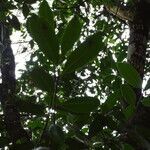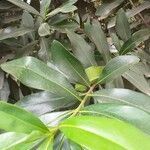It is an evergreen tree. It grows to 25-30 m tall. The leaf canopy is dense and leafy. The bark is rough and brown-black. The bark cracks into rectangular scales. The leaves are dark green and shiny on the upper surface and with the midrib very clear below. The leaves are 10 cm long and the edges of the leaves are wavy. The flowers are green-cream and not easily seen. The fruit is round or egg shaped and 5 cm long. Fruit are on short stalks. The fruit are green to purple and with a waxy white surface. Several seeds occur in the pulp. The seeds are flat and heart shaped. This species has larger fruit than Warburgia salutaris but has sometimes been included with it.
Flowers solitary or in short 3–4-flowered cymes and sometimes with a single flower from the base of the cyme, the true peduncle then being obsolete; peduncle 3 mm. long; bracts ± square, 2 mm. long, very deciduous leaving conspicuous scars; pedicels 3–4 mm. long.
Leaves 3–15 x 1.4–5 cm. oblong-lanceolate, elliptic or oblong-elliptic, often a little falcate, acute at the apex, cuneate at the base, very shiny and dark green above, paler beneath, densely pellucid-dotted; petiole 3–5 mm. long.
Fruit up to 5 cm. in diam., at first greenish and ellipsoidal, later subspherical, turning purplish or with blue-grey bloom when ripe; seeds 1–1.5 cm. long, yellow-brown, compressed, ± cordate.
Tree 5–42 m. tall with rough fissured dark brown or brownish grey bark dividing into rectangular plates; slash often dark red.
Petals: outer 6–7 x 4–4.5 mm.; inner 5–7 x 2.5–3 mm., obovate-spathulate.
Staminal tube 4–5 mm. long; anthers 1.5–2 mm. long.
Sepals thick, 3 x 3–3.5 mm., ciliate.
Ovary 2.6–4 mm. long; ovules 25–30.

